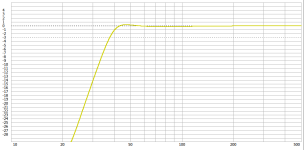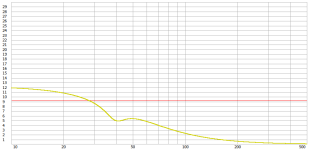New summer, new build plan: a small 2 way (to be complemented with a subwoofer later). Any input welcome before I start buying parts :-D
Goals:

The cone excursion for SB15MFC30 at 50w is problematic <100 Hz, but then the goal is not to push them, and also complement with a sub asap.
What do you guys think? I'm a n00b at crossover design, but it looks to me like they should be fairly easy to integrate?
I'm attaching FRD and ZMA from specs (extracted with FPGraphTracer) and the part specs.
Goals:
- Small / small-ish
- Low to medium SPL (not near field)
- Detailed mid and high frequencies
- Slow bass roll off @ ~80 hz (for sub integration later)
- Tweeter: SB Acoustics SB26CDC, 4 ohms
- Woofer: SB Acoustics SB15MFC30, 4 ohms
- Passive radiator: SB Acoustics 15FSCR
The cone excursion for SB15MFC30 at 50w is problematic <100 Hz, but then the goal is not to push them, and also complement with a sub asap.
What do you guys think? I'm a n00b at crossover design, but it looks to me like they should be fairly easy to integrate?
I'm attaching FRD and ZMA from specs (extracted with FPGraphTracer) and the part specs.
Attachments
Consider the paper cone too. And go for the 4” or 5” waveguide from Somasonus, see the thread and his site. The PR is a good choice. If you have to develop a crossover yourself, get some appropriate measurement gear and use Vituixcad.
A VituixCAD model of the passive-radiator enclosure suggested above produced the following results. Here F3 = 50.4Hz, which is quite close to the results of the WinISD simulation.

However, note that the VituixCAD simulation shown above was done for an input power of only 7.0W re 8Ω. This causes the woofer to exceed its rated Xmax = 5mm for frequencies below 40Hz. This is much lower than the 50W-level mentioned in Post #1. At this power level, the passive radiator seems to be working well within its linear operating range.
However, note that the VituixCAD simulation shown above was done for an input power of only 7.0W re 8Ω. This causes the woofer to exceed its rated Xmax = 5mm for frequencies below 40Hz. This is much lower than the 50W-level mentioned in Post #1. At this power level, the passive radiator seems to be working well within its linear operating range.
Thanks. Will check out the wave guide!Consider the paper cone too. And go for the 4” or 5” waveguide from Somasonus, see the thread and his site. The PR is a good choice. If you have to develop a crossover yourself, get some appropriate measurement gear and use Vituixcad.
I'm somewhat family with REW, and own a measurement microphone. I've only looked at xsim so far but I'll have a look at VituixCAD as well.
Right, I probably only looked at frequencies around 50-100 hz. I'll have a look again.A VituixCAD model of the passive-radiator enclosure suggested above produced the following results. Here F3 = 50.4Hz, which is quite close to the results of the WinISD simulation.
View attachment 1474724
However, note that the VituixCAD simulation shown above was done for an input power of only 7.0W re 8Ω. This causes the woofer to exceed its rated Xmax = 5mm for frequencies below 40Hz. This is much lower than the 50W-level mentioned in Post #1. At this power level, the passive radiator seems to be working well within its linear operating range.
Do you think it will be worth high pass it in the xo to protect it better?
Not only protect. Reducing excursion is very beneficial for midrange performance.
A 2nd-order Butterworth high-pass filter set to 30Hz will certainly help keep the woofer's cone excursion in check. However, the driver's Xmax will still be reached with a low input power. That's inescapable for a small woofer dealing with frequencies around 60Hz or so.Do you think it will be worth high pass it in the xo to protect it better?
Using a 2nd-order high-pass Butterworth filter set to 70Hz would work better. This should allow the high-pass filtered main speakers to blend in with a subwoofer whose low-pass filtering is set to use a 70Hz low-pass Linkwitz–Riley filter. A VituixCAD simulation of this is shown below, with a power input of 18.0W re 8Ω, which is 2.6x what the woofer was previously able to handle.
@Fungrim If you are going to integrate the loudspeakers with a subwoofer, then I would seriously consider using a 12-litre closed-box enclosure right from the get-go. You will reap the benefits of a much simpler, lower-cost enclosure build. You will also have plenty of polyfill in the enclosure to absorb the rear high-frequency radiation from the woofer. That will help to get the best result from the midrange and higher frequency response of the woofer.The cone excursion for SB15MFC30 at 50W is problematic <100 Hz, but then the goal is not to push them, and also complement with a sub ASAP.
Applying a 2nd-order Butterworth 80-Hz high-pass (HP) filter to the loudspeakers will produce an acoustic response whose roll-off is quite similar to that of a 4th-order Linkwitz–Riley HP filter. The simulation below shows that the −6dB point of the filtered response is about 90Hz, which is still quite reasonable. This response would be expected to blend in quite nicely with that of the subwoofer.
The above simulation was done for an input power of 22.0W re 8Ω, and peak SPL in the passband is now around 104dB. The driver excursion reaches 5mm, corresponding to Xmax, peaking at about 72Hz. The dash-dot cyan line is the unfiltered acoustic response of the woofer before any filtering is applied.
Rather than the more "traditional" 80-Hz cut-off, the 90-Hz cut-off was chosen in order to reduce the cone excursion demands placed on the small woofer. The choice of frequency is a trade-off that you can adjust to meet your preferences and design goals.
With the simplified build, and not having to purchase a passive radiator, there will be funds available that should enable you to obtain a subwoofer somewhat sooner than might otherwise have been possible. 🙂
Last edited:
That might not be a good thing.Some people like the Accuton ceramic sound but others don't. I have always found it cold and clangy sounding.Much prefer paper cones.Get the SB15CAC instead. It sounds Accuton-y.
Much more expensive parts is the Meniscus Audio Kairos using some of the best SB Satori drivers but they are a really good speaker and the sealed version integrates well with subs.They rival very good $5000 plus stand mounts and unlike most of them don't have that horrible fake boosted mid bass quality that tends to afflict the breed.
I have the crossover schematics if you want them.
I have the crossover schematics if you want them.
That's somewhat funny – a "ceramic" cone sounding "cold". Looking at the frequency response, there are still quite a few resonances that appear to be quite sharply defined. The paper cones do seem to be a bit better damped. From that perspective, the mineral-filled polypropylene material seems to offer quite good damping of the breakup modes.Some people like the Accuton ceramic sound but others don't. I have always found it cold and clangy sounding. Much prefer paper cones.
Possibly it might be worth considering the SB Acoustics SB17MFC35 6-inch bass-mid driver. It seems to be a little bit better controlled at high frequencies, while still having smooth off-axis radiation characteristics. The rise in the response at high frequencies is a bit more gradual, and therefore should be quite amenable to being kept under control by the crossover network.
Why 12 liter? If one aims for Qtc=1, a simple highpass C would give a nice 3d order rolloff at about 100Hz (just guessing). Which would match an again simple 2nd or 3d order lowpass for the sub. Bigger mid enclosures give challenges reaching neat slopes.then I would seriously consider using a 12-litre closed-box enclosure
The 12-litre enclosure size was what was being considered by the original poster. I was just using that as a guide, rather than going larger or smaller.
Going for a Qtc = 1.0 with the original driver results in very small enclosure sizes (e.g., 1.5 litres). I'm not sure that this would produce a design that is feasible. In a simulation the use of a series capacitor as a high-pass filter produces a reasonable acoustic response, but the very small enclosure volume required would seem to preclude it from being acceptable.
Going for a Qtc = 1.0 with the original driver results in very small enclosure sizes (e.g., 1.5 litres). I'm not sure that this would produce a design that is feasible. In a simulation the use of a series capacitor as a high-pass filter produces a reasonable acoustic response, but the very small enclosure volume required would seem to preclude it from being acceptable.
Last edited:
@Fungrim If you are going to integrate the loudspeakers with a subwoofer, then I would seriously consider using a 12-litre closed-box enclosure right from the get-go. You will reap the benefits of a much simpler, lower-cost enclosure build. You will also have plenty of polyfill in the enclosure to absorb the rear high-frequency radiation from the woofer. That will help to get the best result from the midrange and higher frequency response of the woofer.
Thank you! This is why I love asking question here! I don't mind spec'ing the subwoofer at the same time. Give me an hour and I'll post what I had in mind.
Why 12 liter? If one aims for Qtc=1, a simple highpass C would give a nice 3d order rolloff at about 100Hz (just guessing). Which would match an again simple 2nd or 3d order lowpass for the sub. Bigger mid enclosures give challenges reaching neat slopes.
12-liter was simply what I though was a reasonable size given the 5'' driver / passive radiator. It's nice to know I can scale it down if I want to.
I have the crossover schematics if you want them.
I might take you up on that :-D I was looking at more expensive drivers, but since I'm still a n00b it seemed to me like the SB drivers would be a nice entry point while I'm learning.
Possibly it might be worth considering the SB Acoustics SB17MFC35 6-inch bass-mid driver.
I'll have a look. I was planning on a ~20cm/8inch front panel width with a fairly heavy round-over. I'll sketch it up and see what it looks like with a slightly wider front baffle.
You could also make a ported enclosure and stuff/seal the port once the subwoofer is ready.(to be complemented with a subwoofer later)
@witwald I was thinking something fairly simple for the sub AND something that I could build in similar a similar size/style enclosure as the speakers. Since I was looking the the SB passive radiator already I modeled the Tang Band W5-1138SMF in a 16l box (the front baffle can stay the same as for the speakers, and the depth being increased) with the same PR.
It's a sharp drop-off below 45 Hz, but that's fine with me in this build.

Cone excursion at 40w seems OK down to ~30 Hz.

I was considering a MiniDSP for the sub/woofer integration, but now I'm tempted to do it with a physical XO for the sub as well. It seems like an excellent learning opportunity :-D
It's a sharp drop-off below 45 Hz, but that's fine with me in this build.

Cone excursion at 40w seems OK down to ~30 Hz.

I was considering a MiniDSP for the sub/woofer integration, but now I'm tempted to do it with a physical XO for the sub as well. It seems like an excellent learning opportunity :-D
Attachments
- Home
- Loudspeakers
- Multi-Way
- 2 Way SB Acoustics, initial feedback